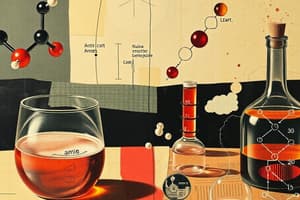Podcast
Questions and Answers
What type of compound is formed when a primary amine reacts with an acid?
What type of compound is formed when a primary amine reacts with an acid?
Salt
What is the name given to the reaction where primary aromatic amines are converted to diazonium salts?
What is the name given to the reaction where primary aromatic amines are converted to diazonium salts?
Diazotisation
Which of the following types of amine will give a positive carbylamine reaction?
Which of the following types of amine will give a positive carbylamine reaction?
- Primary amine (correct)
- Tertiary amine
- Secondary amine
Aromatic amines are generally stronger bases compared to aliphatic amines.
Aromatic amines are generally stronger bases compared to aliphatic amines.
What kind of compound results from the reduction of nitro compounds?
What kind of compound results from the reduction of nitro compounds?
The Gabriel phthalimide synthesis is a suitable method for preparing aromatic primary amines.
The Gabriel phthalimide synthesis is a suitable method for preparing aromatic primary amines.
The Hoffman bromide degradation reaction results in the formation of a product with one carbon less.
The Hoffman bromide degradation reaction results in the formation of a product with one carbon less.
Which reagent is used for the Hinsberg test to distinguish between primary, secondary and tertiary amines?
Which reagent is used for the Hinsberg test to distinguish between primary, secondary and tertiary amines?
Flashcards
Diazotization Reaction
Diazotization Reaction
A reaction where an aromatic primary amine reacts with nitrous acid to form a diazonium salt.
Hoffman Bromide Reaction
Hoffman Bromide Reaction
A reaction that converts secondary amines to primary amines with one less carbon in the product.
Gabriel Phthalimide Synthesis
Gabriel Phthalimide Synthesis
A method for preparing primary amines, specifically aliphatic ones, from phthalimide.
Coupling Reaction
Coupling Reaction
Signup and view all the flashcards
Carbylamine Reaction
Carbylamine Reaction
Signup and view all the flashcards
Reduction of Nitro Compounds
Reduction of Nitro Compounds
Signup and view all the flashcards
Primary Amine
Primary Amine
Signup and view all the flashcards
Secondary Amine
Secondary Amine
Signup and view all the flashcards
Aromatic Amine
Aromatic Amine
Signup and view all the flashcards
Aliphatic Amine
Aliphatic Amine
Signup and view all the flashcards
Diazonium Salt
Diazonium Salt
Signup and view all the flashcards
Isocyanide
Isocyanide
Signup and view all the flashcards
Phenol
Phenol
Signup and view all the flashcards
Aniline
Aniline
Signup and view all the flashcards
Azo Compound
Azo Compound
Signup and view all the flashcards
Study Notes
Amines: Revision Notes
- Amines are nucleophilic and are basic in nature.
- They react with acids to form salts.
- Aliphatic amines are stronger bases than aromatic amines due to the +I effect.
Name Reactions
- Diazotization: Converts primary aromatic amines to diazonium salts.
- Hoffman Bromide Reaction: Converts amide to primary amine. Works for both aliphatic and aromatic compounds.
- Gabriel Phthalamide Synthesis: Used to prepare primary aliphatic amines.
- Coupling Reaction: Used for preparation of azo compounds.
- Carbylamine Reaction/Isocyanide Test: Differentiates primary amines from secondary and tertiary amines using chloroform and potassium hydroxide.
Preparations
- Reduction of Nitro Compounds: Converting nitro compounds into amines using hydrogen/palladium or tin/hydrochloric acid. Iron and hydrochloric acid is often preferred because the iron forms intermediate compounds that gets hydrolyzed to release ammonia.
- Ammonolysis of alkyl halides: Reaction of alkyl halides with ammonia to form amines.
- Reduction of Nitriles: Converting nitriles into amines using hydrogen/nickel, or sodium amalgam and alcohol. This is used to increase the carbon chain by one.
- Reduction of Amides: Converting amides into amines using lithium aluminum hydride.
- Gabriel Phthalamide Synthesis: Used to prepare aromatic 1° amines and avoid 2° and 3° amines.
Chemical Reactions
-
Basic Character: Amines react with acids to form salts, which are soluble in water.
-
Acylation: Reaction between amines and acylating agents to form amides or other derivatives.
-
Diazotization Reactions: Chemical reactions in which primary aromatic amines are treated with nitrous acid (usually as sodium nitrite) and an acid. This produces stable diazonium salts, which are intermediates for the synthesis of a variety of products.
-
Electrophilic Substitution Reactions: Amine groups can undergo aromatic electrophilic substitution reactions. These reactions involve replacing a hydrogen atom in the benzene ring with an electrophile. Bromination and nitration are often used for this purpose.
-
Sulphonation: Addition of a sulphonic acid group (SO3H).
Tests
- Carbylamine Test: Used to distinguish primary amines from secondary and tertiary amines. Primary amines react to form isocyanides (carbylamines), which are foul-smelling.
- Reaction with Nitrous Acid: Used to distinguish primary and higher-order amines.
- Reaction with Aryl Sulphonyl Chloride: Used to differentiate among primary, secondary, and tertiary amines.
Studying That Suits You
Use AI to generate personalized quizzes and flashcards to suit your learning preferences.




